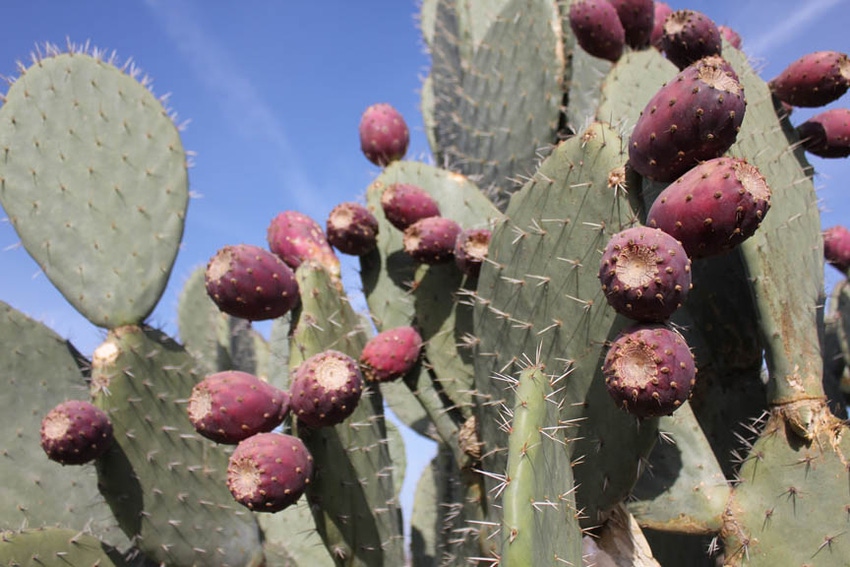January 30, 2014

A pioneering effort to bring a nutritious new crop to challenging soils on the San Joaquin Valley’s West Side mirrors the old saying about making lemonade when all the world gives you is lemons.
Given a scarcity of water and salty soil rich in boron and selenium, researchers five years ago began looking at growing prickly pear cactus that requires less water than most crops and produces fruit that can be used in a variety of ways — for juice, jams, jellies and other products.
And thanks to a rare mineral mix on the challenged land that is part of John Diener’s Red Rock Ranch, the cacti take up only small quantities of selenium, volatizing some of it and keeping some in their fruit and leaf-like stems called cladodes.
The selenium in food products from the cactus – from the family Opuntia ficus indica -- brings added nutritional value for people, said Gary Banuelos, a research scientist with the U.S. Department of Agriculture.
“This is potentially a viable commercial crop,” Banuelos said. Diener, who has collaborated with Banuelos on 20 years of research, agrees.
“John is my realty barometer,’ said Banuelos, referring to tests on whether a crop has commercial potential.
Diener, who grows a wide range of crops on 4,000 acres, has between 8 and 10 acres of the prickly pear cactus now and said he potentially could grow as much as 200 acres.
Banuelos said the cactus is considered a permanent crop that could produce fruit for up to 15 years.
Diener said the soil on which the cacti are grown is common only to a half dozen places in the world, providing the chemistry that enables the capture of selenium in the plant, in part because high sulfur content cuts down on the amount of selenium the plant absorbs..
Ancient seas that once covered the Valley’s West Side left behind marine sediments, shale formation and deposits of selenium and other materials. Drainage water and runoff from irrigation, when they contain high levels of selenium, can be toxic to fish, migratory birds and other wildlife that drink from waterways and drainage ditches.
“Selenium is a biological contaminant at excessive levels, but it can also be seen as a reservoir,” said Banuelos, an Agricultural Research Service plant/soil scientist with the Water Management Research Unit at the San Joaquin Valley Agricultural Sciences Center in Parlier.
Diener added, “If there’s not enough, it can be a problem; if there’s too much it’s a problem.”
Opuntia is native to the American Southwest and has been introduced in many other countries in the Mediterranean and western Pacific regions, Banuelos said. It typically grows wild in desert and arid regions,.
After applying for and securing funding from the California State University Agricultural Research Institute and the California Department of Water Resources, Banuelos started work on the commercial sized trial plot with Diener.
Banuelos and colleagues from the University of Palermo, Italy, initially evaluated varieties of the Opuntia cactus from the USDA-ARS National Arid Land Genetics Resources Unit at Parlier.
Cactus nirvana
From 40 varieties, they chose five “top performers” that seemed best suited to the salty soils on Diener’s ranch.
At the Parlier research center, Banuelos pointed out a two acre field plot where “parent” cacti were grown as part of the selection process. Because the fruit is handpicked, preference was given to varieties that lacked spines.
The “parent” plot is well irrigated and sits on good quality soil.
“It’s nirvana for them,” Banuelos said of that group of relatively pampered plants.
He also pointed out a half-acre experimental plot where soil had been excavated and replaced with drainage sediment from the San Luis Reservoir.
Cuttings from the leaf-like cladode form a scab and are then put into soil with moisture to create new plantings.
Fruits from the cactus were initially processed by former Fresno State University food science professor Gour Choudhury. Wawona Frozen Foods in Clovis helped with storage of the fruit. Later, Banuelos would partner with Mercer Processing Co. in Modesto to develop trial batches of products.
The result is four new cultivar patents co-owned by Fresno State, Deiner’s Red Rock Ranch and the USDA. Red Rock Ranch intends to develop and market products in the form of juice and powder blends derived from the new plants.
Diener said the patents were important to “get some profitability out of it and to protect the quality of the plant” and guard against false claims by producers.
He said challenges to growing Opuntia come from gopher activity and the fact that there are no federally approved chemicals that can be used on the crop to mitigate that.
“The gophers are everywhere,” said Banuelos. “It’s about the only thing there is out there that they can eat.”
Banuelos said rabbits posed a problem at one point, but that was abated by sprinkling the plants with ground chili pepper.
He said birds that roost in poplar trees planted nearby, for another project on biofuels, do not seem to pose a problem. In fact, some occasionally take out gophers if they leave their tunnels and emerge atop the soil.
Banuelos is pleased with the promise that Opuntia could provide for using West Side soils that have become too harsh for growing conventional crops.
Banuelos and Diener have worked on other projects that involved crops tolerant of salinity and boron and able to pull some selenium from the soil, including mustards and canola.
Banuelos said the cactus grown in challenging conditions may actually have a higher nutritional value because of adaptations it makes. And he is also looking at deficit irrigation in grapes, peaches and pomegranates to see if nutritional value can actually be increased by some water deprivation.
More from Western Farm Press
Organic rant from unhappy reader; musings from corporate-funded editor
Farmer privacy breach brings suit against EPA
About the Author(s)
You May Also Like




